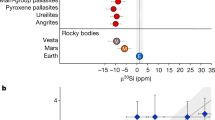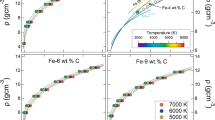Abstract
Similar to Earth, many large planetesimals in the Solar System experienced planetary-scale processes such as accretion, melting and differentiation. As their cores cooled and solidified, substantial chemical fractionation occurred due to solid metal–liquid metal fractionation. Iron meteorites—core remnants of these ancient planetesimals—record a history of this process. Recent iron isotope analyses of iron meteorites found their 57Fe/54Fe ratios to be heavier than chondritic by approximately 0.1 to 0.2 per mil for most meteorites, indicating that a common parent body process was responsible. However, the mechanism for this fractionation remains poorly understood. Here we experimentally show that the iron isotopic composition of iron meteorites can be explained solely by core crystallization. In our experiments of core crystallization at 1,300 °C, we find that solid metal becomes enriched in the heavier iron isotope by 0.13 per mil relative to liquid metal. Fractional crystallization modelling of the IIIAB iron meteorite parent body shows that observed iridium, gold and iron compositions can be simultaneously reproduced during core crystallization. The model implies the formation of complementary sulfur-rich components of the iron meteorite parental cores that remain unsampled by meteorite records and may be the missing reservoir of isotopically light iron. The lack of sulfide meteorites and previous trace element modelling predicting substantial unsampled volumes of iron meteorite parent cores support our findings.
This is a preview of subscription content, access via your institution
Access options
Access Nature and 54 other Nature Portfolio journals
Get Nature+, our best-value online-access subscription
$29.99 / 30 days
cancel any time
Subscribe to this journal
Receive 12 print issues and online access
$259.00 per year
only $21.58 per issue
Buy this article
- Purchase on Springer Link
- Instant access to full article PDF
Prices may be subject to local taxes which are calculated during checkout




Similar content being viewed by others
Data availability
The data supporting the findings of this study are available within the article and its Supplementary Information files. All new data associated with this paper will be made publicly available via figshare (https://figshare.com/).
References
Hin, R. C. et al. Magnesium isotope evidence that accretional vapour loss shapes planetary compositions. Nature 549, 511–515 (2017).
Young, E. D. Near-equilibrium isotope fractionation during planetesimal evaporation. Icarus 323, 1–15 (2019).
Shahar, A. et al. Pressure-dependent isotopic composition of iron alloys. Science 352, 580–582 (2016).
Elardo, S. M. & Shahar, A. Non-chondritic iron isotope ratios in planetary mantles as a result of core formation. Nat. Geosci. 10, 317–321 (2017).
Liu, J. et al. Iron isotopic fractionation between silicate mantle and metallic core at high pressure. Nat. Commun. 8, 14377 (2017).
Elardo, S. M., Shahar, A., Mock, T. D. & Sio, C. K. The effect of core composition on iron isotope fractionation between planetary cores and mantles. Earth Planet. Sci. Lett. 513, 124–134 (2019).
Williams, H. M., Wood, B. J., Wade, J., Frost, D. J. & Tuff, J. Isotopic evidence for internal oxidation of the Earth’s mantle during accretion. Earth Planet. Sci. Lett. 321, 54–63 (2012).
Benedix, G. K., Haack, H. & McCoy, T. J. in Treatise on Geochemistry 2nd edn (eds Holland, H. D. & Turekian, K. K.) 267–285 (Elsevier, 2014).
Poitrasson, F., Levasseur, S. & Teutsch, N. Significance of iron isotope mineral fractionation in pallasites and iron meteorites for the core–mantle differentiation of terrestrial planets. Earth Planet. Sci. Lett. 234, 151–164 (2005).
Schoenberg, R. & von Blanckenburg, F. Modes of planetary-scale Fe isotope fractionation. Earth Planet. Sci. Lett. 252, 342–359 (2006).
Williams, H. M. et al. Fe isotope fractionation in iron meteorites: new insights into metal-sulphide segregation and planetary accretion. Earth Planet. Sci. Lett. 250, 486–500 (2006).
Jordan, M. K., Tang, H., Kohl, I. E. & Young, E. D. Iron isotope constraints on planetesimal core formation in the early Solar System. Geochim. Cosmochim. Acta 246, 461–477 (2019).
Luck, J.-M., Othman, D. B. & Albarède, F. Zn and Cu isotopic variations in chondrites and iron meteorites: early solar nebula reservoirs and parent-body processes. Geochim. Cosmochim. Acta 69, 5351–5363 (2005).
Bishop, M. C. et al. The Cu isotopic composition of iron meteorites. Meteorit. Planet. Sci. 47, 268–276 (2012).
Chen, H., Moynier, F., Humayun, M., Bishop, M. C. & Williams, J. T. Cosmogenic effects on Cu isotopes in IVB iron meteorites. Geochim. Cosmochim. Acta 182, 145–154 (2016).
Shahar, A., Elardo, S. M. & Macris, C. A. Equilibrium fractionation of non-traditional stable isotopes: an experimental perspective. Rev. Mineral. Geochem. 82, 65–83 (2017).
de Moya, A., Pinilla, C., Morard, G. & Blanchard, M. Computational modelling of iron isotope fractionation in solid and molten FeS metal alloys. Goldschmidt Abstracts 2019, abstr. 773 (2019).
Chabot, N. L. & Haack, H. in Meteorites and the Early Solar System II (eds Lauretta, D. S. & McSween, H. Y. Jr) 747–771 (LPI, 2006).
Goldstein, J. I., Scott, E. R. D. & Chabot, N. L. Iron meteorites: crystallization, thermal history, parent bodies, and origin. Geochemistry 69, 293–325 (2009).
Chabot, N. L., Wollack, E. A., McDonough, W. F., Ash, R. D. & Saslow, S. A. Experimental determination of partitioning in the Fe–Ni system for applications to modeling meteoritic metals. Meteorit. Planet. Sci. 52, 1133–1145 (2017).
Wasson, J. T. Trapped melt in IIIAB irons; solid/liquid elemental partitioning during the fractionation of the IIIAB magma. Geochim. Cosmochim. Acta 63, 2875–2889 (1999).
Wasson, J. T. & Choi, B.-G. Main-group pallasites: chemical composition, relationship to IIIAB irons, and origin. Geochim. Cosmochim. Acta 67, 3079–3096 (2003).
Chabot, N. L. Revised trapped melt model for iron meteorites. In Proc. 82nd Annual Meeting of The Meteoritical Society Contrib. no. 2157 (LPI, 2019).
Yang, J. & Goldstein, J. I. Metallographic cooling rates of the IIIAB iron meteorites. Geochim. Cosmochim. Acta 70, 3197–3215 (2006).
Wasson, J. T. Formation of the Treysa quintet and the main-group pallasites by impact-generated processes in the IIIAB asteroid. Meteorit. Planet. Sci. 51, 773–784 (2016).
Polyakov, V. B., Clayton, R. N., Horita, J. & Mineev, S. D. Equilibrium iron isotope fractionation factors of minerals: reevaluation from the data of nuclear inelastic resonant X-ray scattering and Mössbauer spectroscopy. Geochim. Cosmochim. Acta 71, 3833–3846 (2007).
Dauphas, N. et al. A general moment NRIXS approach to the determination of equilibrium Fe isotopic fractionation factors: application to goethite and jarosite. Geochim. Cosmochim. Acta 94, 254–275 (2012).
Krawczynski, M. J., Van Orman, J. A., Dauphas, N., Alp, E. E. & Hu, M. Iron isotope fractionation between metal and troilite: a new cooling speedometer for iron meteorites. In Proc. 45th Lunar and Planetary Science Conference No. 2755 (Pergamon, 2014).
Hsieh, K.-C. & Chang, Y. A. Thermochemical description of the ternary iron–nickel–sulfur system. Can. Metall. Q. 26, 311–327 (1987).
D’orazio, M., Folco, L., Chaussidon, M. & Rochette, P. Sahara 03505 sulfide-rich iron meteorite: evidence for efficient segregation of sulfide-rich metallic melt during high-degree impact melting of an ordinary chondrite. Meteorit. Planet. Sci. 44, 221–231 (2009).
Chabot, N. L. Sulfur contents of the parental metallic cores of magmatic iron meteorites. Geochim. Cosmochim. Acta 68, 3607–3618 (2004).
Kracher, A. & Wasson, J. T. The role of S in the evolution of the parental cores of the iron meteorites. Geochim. Cosmochim. Acta 46, 2419–2426 (1982).
Poitrasson, F., Halliday, A. N., Lee, D.-C., Levasseur, S. & Teutsch, N. Iron isotope differences between Earth, Moon, Mars and Vesta as possible records of contrasted accretion mechanisms. Earth Planet. Sci. Lett. 223, 253–266 (2004).
Weyer, S. et al. Iron isotope fractionation during planetary differentiation. Earth Planet. Sci. Lett. 240, 251–264 (2005).
Anand, M., Russell, S. S., Blackhurst, R. L. & Grady, M. M. Searching for signatures of life on Mars: an Fe-isotope perspective. Philos. Trans. R. Soc. Lond. B 361, 1715–1720 (2006).
Craddock, P. R. & Dauphas, N. Iron isotopic compositions of geological reference materials and chondrites. Geostand. Geoanal. Res. 35, 101–123 (2010).
Wang, K. et al. Iron isotope fractionation in planetary crusts. Geochim. Cosmochim. Acta 89, 31–45 (2012).
Craddock, P. R., Warren, J. M. & Dauphas, N. Abyssal peridotites reveal the near-chondritic Fe isotopic composition of the Earth. Earth Planet. Sci. Lett. 365, 63–76 (2013).
Teng, F.-Z., Dauphas, N., Huang, S. & Marty, B. Iron isotopic systematics of oceanic basalts. Geochim. Cosmochim. Acta 107, 12–26 (2013).
Sossi, P. A., Nebel, O. & Foden, J. Iron isotope systematics in planetary reservoirs. Earth Planet. Sci. Lett. 452, 295–308 (2016).
Sossi, P. A. & Moynier, F. Chemical and isotopic kinship of iron in the Earth and Moon deduced from the lunar Mg-suite. Earth Planet. Sci. Lett. 471, 125–135 (2017).
Smoliar, M. I., Walker, R. J. & Morgan, J. W. Re–Os Ages of group IIA, IIIA, IVA, and IVB iron meteorites. Science 271, 1099–1102 (1996).
Horan, M. F., Smoliar, M. I. & Walker, R. J. 182W and 187Re-187Os systematics of iron meteorites: chronology for melting, differentiation, and crystallization in asteroids. Geochim. Cosmochim. Acta 62, 545–554 (1998).
Becker, H. & Walker, R. J. In search of extant T c in the early solar system: 98Ru and 99Ru abundances in iron meteorites and chondrites. Chem. Geol. 196, 43–56 (2003).
Walker, R. J. et al. Modeling fractional crystallization of group IVB iron meteorites. Geochim. Cosmochim. Acta 72, 2198–2216 (2008).
Malvin, D. J., Jones, J. H. & Drake, M. J. Experimental investigations of trace element fractionation in iron meteorites. III: elemental partitioning in the system Fe–Ni–S–P. Geochim. Cosmochim. Acta 50, 1221–1231 (1986).
Dauphas, N., John, S. G. & Rouxel, O. Iron isotope systematics. Rev. Mineral. Geochem. 82, 415–510 (2017).
Acknowledgements
We thank T. D. Mock for help with the MC-ICP-MS, M. F. Horan for help in the clean lab, and E. S. Bullock for help with the electron microprobe analyses. P.N. was supported by a Carnegie Postdoctoral Fellowship while working on this project. This research is partially supported by NASA grant NNX15AJ27G to N.L.C. We thank the APL internship programme for enabling contributions by C.J.R.
Author information
Authors and Affiliations
Contributions
P.N., N.L.C. and A.S. designed the research project. C.J.R. and N.L.C. conducted the experiments, examined the run products and prepared them for analyses. P.N. and A.S. performed the clean lab chemistry and Fe isotope measurements and analysed the data. P.N. drafted the manuscript, and all authors contributed to writing the paper.
Corresponding author
Ethics declarations
Competing interests
The authors declare no competing interests.
Additional information
Peer review information Primary Handling Editor: Tamara Goldin.
Publisher’s note Springer Nature remains neutral with regard to jurisdictional claims in published maps and institutional affiliations.
Supplementary information
Supplementary Information
Supplementary discussions, Figs. 1–6 and Tables 1–4.
Rights and permissions
About this article
Cite this article
Ni, P., Chabot, N.L., Ryan, C.J. et al. Heavy iron isotope composition of iron meteorites explained by core crystallization. Nat. Geosci. 13, 611–615 (2020). https://doi.org/10.1038/s41561-020-0617-y
Received:
Accepted:
Published:
Issue Date:
DOI: https://doi.org/10.1038/s41561-020-0617-y
This article is cited by
-
The Geochemical Legacy of Low-Temperature, Percolation-Driven Core Formation in Planetesimals
Earth, Moon, and Planets (2023)



